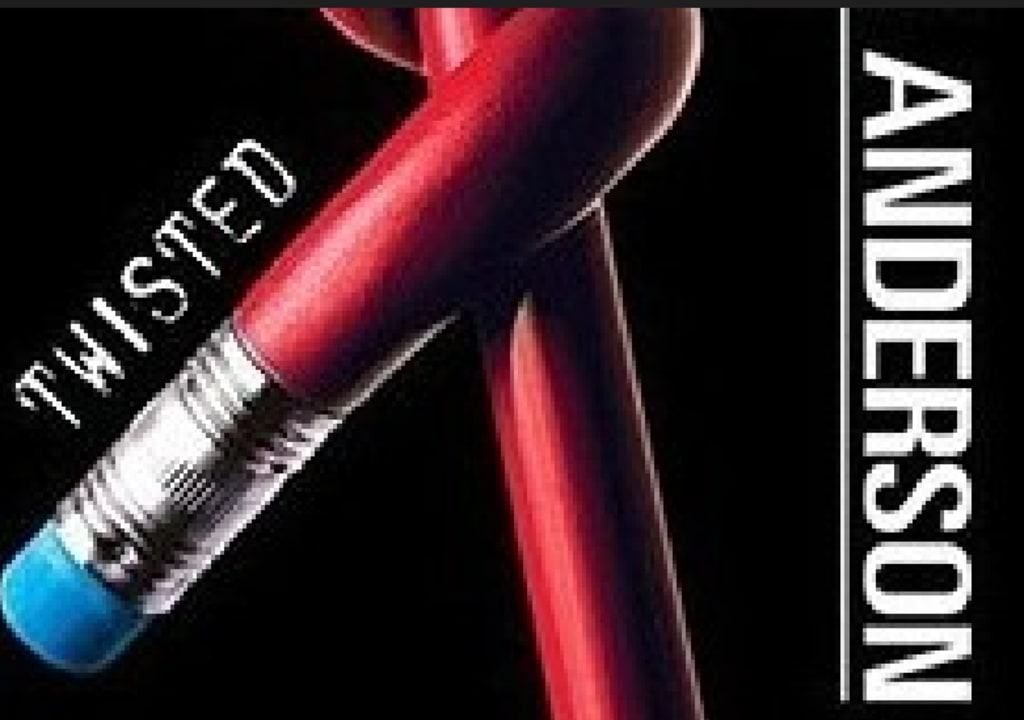Twisted, by Laurie Halse Anderson
Essential reading for any high school student

It was 2007; I was in graduate school, getting my masters in Secondary ELA Education, on my way to becoming a high school English teacher. I’m starting the first round of my student teaching, and on my first day at this particular school, I was given a rather brief tour of the school. When I went into the uncomfortably tight guidance office, a book on the counselor’s shelf caught my eye. It was a dark, reflective black cover, and on it was a bright red pencil that twirled around itself at the top. The glaring colors against the deep black backdrop grabbed my attention, as did the title etched in stark white going up the side of the pencil. Simple, sharp. Twisted. I picked it up and looked it over, and the counselor began to gush. “Oh, it’s so good.” “You’ll read it in one sitting.” “Just the best young adult novel you could ask for.” All glowing recommendations.
What stood out to me most was the author: Laurie Halse Anderson. Six years’ prior, I was at my girlfriend’s house when she handed me a book called Speak, also by Anderson. Speak won a few thousand awards, and I wanted to make my girlfriend think I was cultured and well-read, so I gave it a try. Speak was good, worthy of all its acclaim, but if you’ll pardon the pun, it didn’t speak to me. And the reason was obvious: Speak was told from the perspective of a 14-year-old girl who’d overcome a great deal of trauma. I was neither a 14-year-old girl, nor had I endured the type of trauma that the book's protagonist had overcome. But what I took away from the novel was that Laurie Halse Anderson was an incredibly talented author (one who I have admittedly stolen a great deal from in trying to build my own writing style), and I was willing to give her another try just based off her talent alone. I went to the library, checked out a copy, and went to work.
Between classes and downtime at my job, I read Twisted in two days. It was hard to put down. But what drew me to this novel was the exact reason I didn’t connect to Speak: the protagonist was more relatable than any character I’d ever read. Twisted tells the story of an 18-year old boy- or man- named Tyler, entering his last year of high school. He made a terribly bad decision, and that decision changed how people looked at him, both the good and the bad. And through a complicated tapestry of building conflicts, Twisted lived by its namesake, providing a conflict that built upon the plot in dramatic and exciting ways. I was hooked by the characterization, and once hooked, the rising conflict kept me turning one page after the next.
Within the first five chapters (these chapters are remarkably short, for reference), Anderson had established a first-person voice that could have been ripped right from my mouth. Tyler was awkward and over-analytical, as was I when I was in high school. He was obsessed with girls and perverse in most of his thoughts, as was I. He was angry, verbally-abusive at times, and undoubtedly suffering from some level of depression.
As was I.
What stayed with me was that Laurie Halse Anderson had developed, through Speak’s protagonist Melinda, a tone-perfect, exceptional voice. It was remarkable how well-developed that voice was, as if Anderson had lived in the head of a 14-year old girl (which she no doubt had, at some point). But (and I could be wrong), I don’t believe Anderson was ever an 18-year old boy, and I was floored that she so accurately nailed the voice of one. And that’s when I saw first-hand what real talent looked like in a writer, which is why I have so passionately mapped my fiction writing style around Anderson’s.
Clearly, as a reader, the book hooked me, deep. As an aspiring writer, Anderson’s incredible storytelling and powerful character development and voice inspired me and bettered my abilities (or so I hope). But where Twisted really affected my life was as a teacher. Like I’d said, I was a graduate school student and was working towards becoming a high school English teacher. My school focused all of our training on literacy and development, and one of the primary concerns we’d discussed again and again was one simple question: how do we get young men to want to read? Girls you typically had no problem with, but young men have their interests pulled in so many different directions that reading becomes of little concern to them. In all my studies of theory and pedagogy, I had decided that I was going to begin all of my classes with a high-interest, accessible young adult novel. And after I had read Twisted, I knew that this had to be that novel. Seniors, Sophomores, whatever; it didn’t matter. Every class I taught would read this book.
Because this book makes people want to read.
It couldn’t be more important for young people to read this. It starts with a warning page in front of the title page that states that it is “not a book for children.” At the time, I thought that this was a marketing trick, some way of saying “beware: big, scary book with scary stuff in it” to trick young people into wanting to read it. I now assure every student I teach that it is, indeed, not a book for children. Tyler makes many inappropriate assertions about sexuality. Why? Because these are things that young men think. Tyler judges people and makes terrible decisions. Why? Because young men do these things. Tyler reacts poorly and verbally abuses people that he loves. Why? Have you interacted with a young man recently?
This book discusses, at length, the act of suicide. Tyler deals with depression, anxiety, and regular suicidal thoughts. And without giving anything away, Tyler has to deal with the very real possibility that he might end his own life. Anderson handles this with such sincerity and such grace that I read it, I wept, and I knew that this book was important to have my students read. Why? Because in sixteen years as a professional educator, I’ve lost count of how many students I’ve held weeping because some friend, somebody who walked the halls of the high school every day, felt the need to end their life. Or some cousin, some sibling, some parent, even, thought that ending it was the right call. This book tackles that subject in a way that will leave the reader feeling empowered; if one young person is thinking about killing him or herself and reads this book and realizes how terrible that call is, then Laurie Halse Anderson will have saved a life. I’m proud of my writing, but I don’t think my words have ever saved someone’s life before. Maybe one day.
So now I’m in year sixteen as an educator; I teach lowly, lowly Sophomores in a humble high school. I have to prepare them for the state test, building them into capable readers and writers. But the first thing we do, every semester, is read Twisted by Laurie Halse Anderson. Hundreds of students have read this book based purely off my class and recommendation. I’ve lost count of how many avid readers are born just by reading this one book. And now, as I reflect back on it, there’s no telling how many lives have been saved as a result.
About the Creator
Bryan Buffkin
Bryan Buffkin is a high school English teacher, a football and wrestling coach, and an aspiring author from the beautiful state of South Carolina. His writing focuses on humorous observational musings and inspirational fiction.






Comments
There are no comments for this story
Be the first to respond and start the conversation.